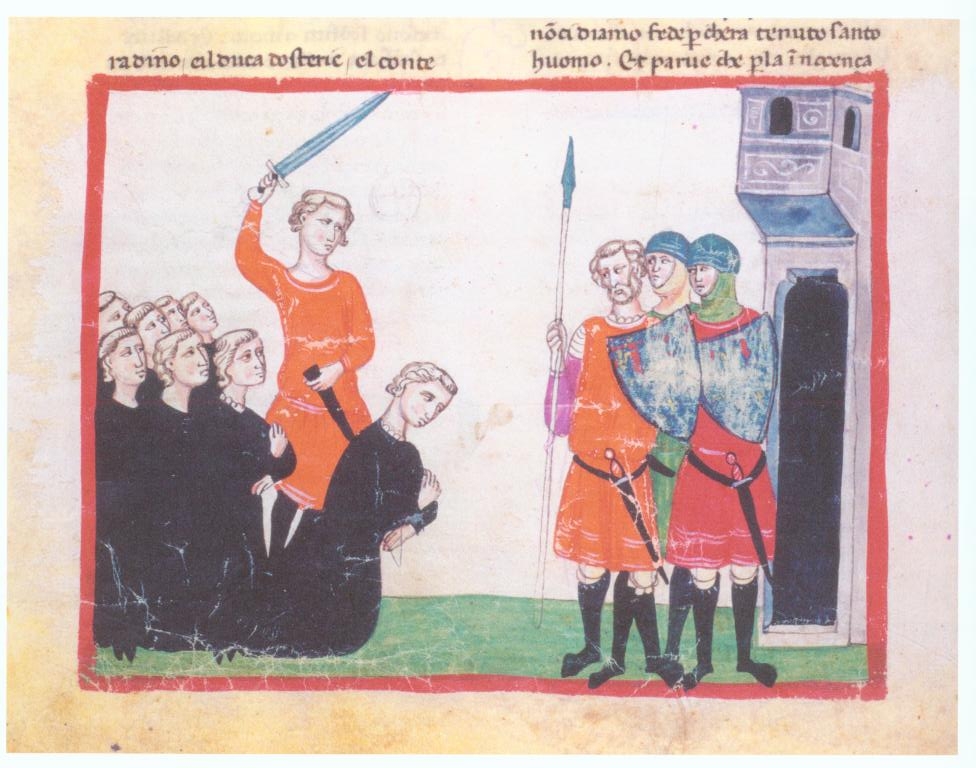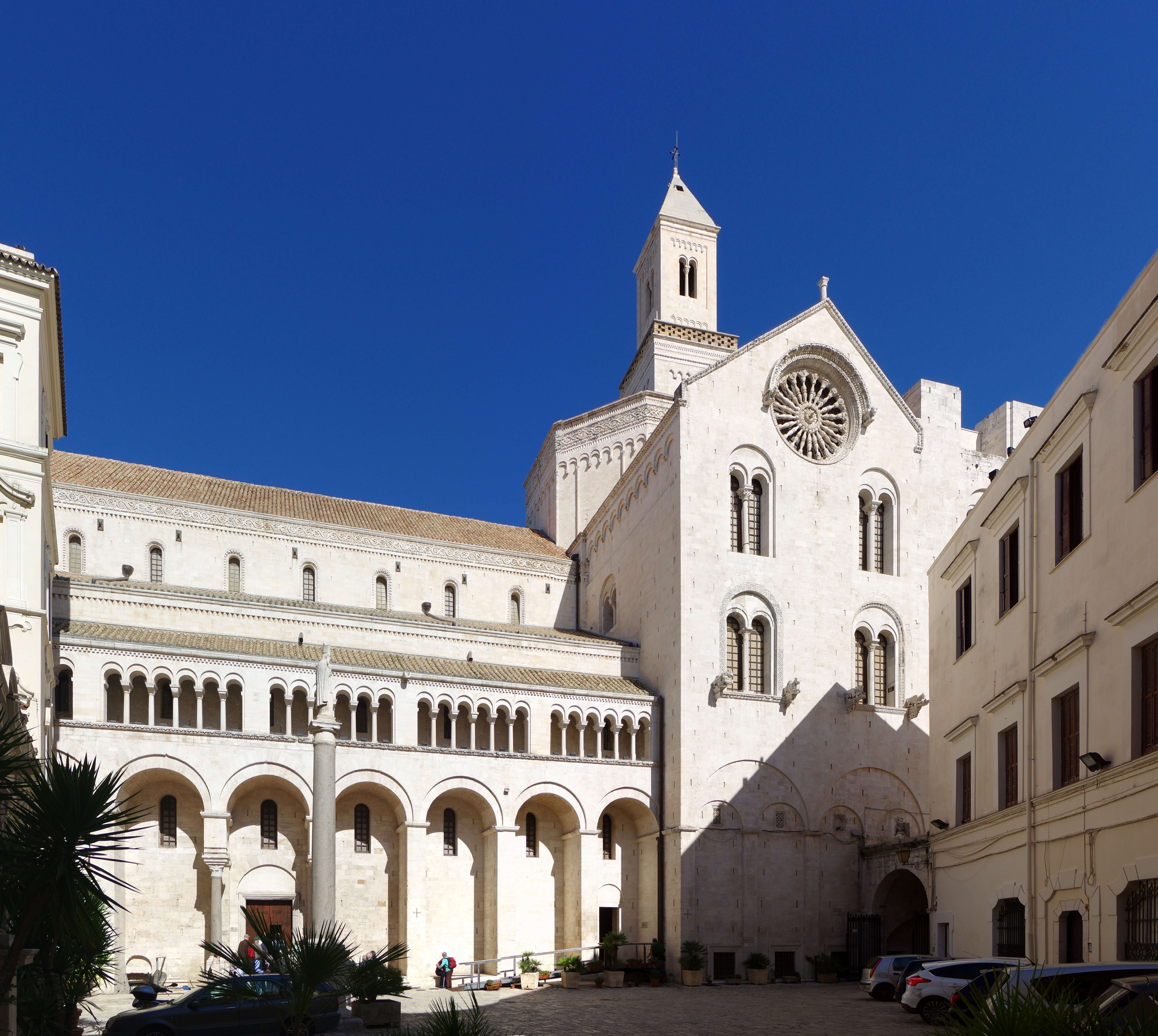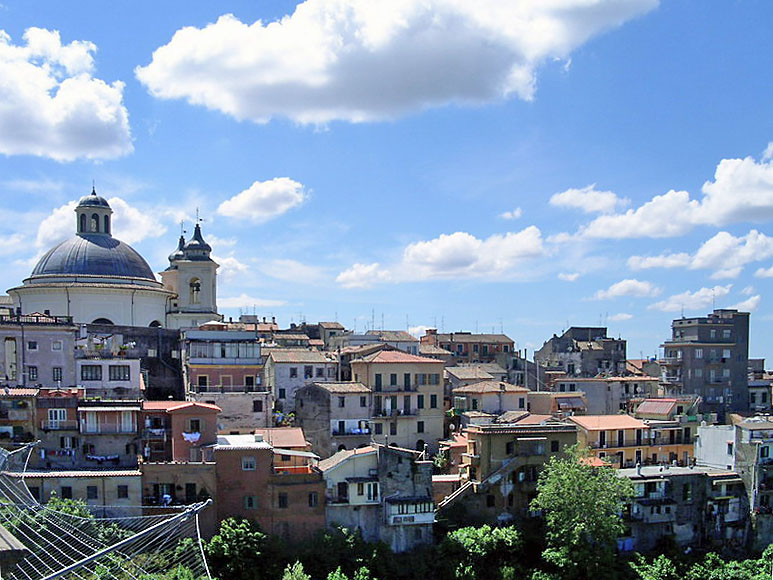|
Enrico Filangieri
Enrico Filangieri (died 10 October 1258) was an Italian nobleman and Dominican friar who served as the archbishop of Bari in the Kingdom of Sicily from May 1252 until his death. Enrico was a scion of the Filangieri family, the son of Guido, lord of Nocera, and nephew of Marino Filangieri, archbishop of Bari (died 1251). He had two brothers: Pietro (died 1290), a papal chaplain, and Riccardo, who was made count of Marsico by King Manfred. He was born before 1220 and entered the Dominican Order, probably joining the convent established in Naples by Tommaso Agni da Lentini in 1231. He received a higher education, probably also in Naples. By 1243, Enrico had left the Kingdom of Sicily because of the Emperor Frederick II's hostility to his family. While he was still in exile, he was appointed archbishop of Bari at Perugia on 6 May 1252 by the papal legate Pietro da Collemezzo, acting on the orders of Pope Innocent IV, who ratified the appointment on 10 May. He was unable to take ... [...More Info...] [...Related Items...] OR: [Wikipedia] [Google] [Baidu] |
Italo-Norman
The Italo-Normans ( it, Italo-Normanni), or Siculo-Normans (''Siculo-Normanni'') when referring to Sicily and Southern Italy, are the Italian-born descendants of the first Norman conquerors to travel to southern Italy in the first half of the eleventh century. While maintaining much of their distinctly Norman piety and customs of war, they were shaped by the diversity of southern Italy, by the cultures and customs of the Greeks, Lombards, and Arabs in Sicily. History Normans first arrived in Italy as pilgrims, probably on their way to or returning from either Rome or Jerusalem, or from visiting the shrine at Monte Gargano, during the late tenth and early eleventh centuries. In 1017, the Lombard lords in Apulia recruited their assistance against the dwindling power of the Byzantine Catapanate of Italy. They soon established vassal states of their own and began to expand their conquests until they were encroaching on the Lombard principalities of Benevento and Capua, Saracen ... [...More Info...] [...Related Items...] OR: [Wikipedia] [Google] [Baidu] |
Conrad IV
Conrad (25 April 1228 – 21 May 1254), a member of the Hohenstaufen dynasty, was the only son of Emperor Frederick II from his second marriage with Queen Isabella II of Jerusalem. He inherited the title of King of Jerusalem (as Conrad II) upon the death of his mother in childbed. Appointed Duke of Swabia in 1235, his father had him elected King of Germany (King of the Romans) and crowned King of Italy (as Conrad IV) in 1237. After the emperor was deposed and died in 1250, he ruled as King of Sicily (Conrad I) until his death. Early years He was the second child, but only surviving son of Emperor Frederick II and Isabella II (Yolanda), the queen regnant of Jerusalem. Born in Andria, in the South Italian Kingdom of Sicily, his mother died shortly after giving birth to him and he succeeded her as monarch of the Crusader state of Jerusalem. By his father, Conrad was the grandson of the Hohenstaufen emperor Henry VI and great-grandson of Emperor Frederick Barbarossa. He lived i ... [...More Info...] [...Related Items...] OR: [Wikipedia] [Google] [Baidu] |
San Domenico Maggiore
San Domenico Maggiore is a Gothic, Roman Catholic church and monastery, founded by the friars of the Dominican Order, and located in the square of the same name in the historic center of Naples. History The square is bordered by a street/alleyway popularly called " Spaccanapoli" (presently labeled via Benedetto Croce at this particular section of its considerable length) in the historic center of Naples. It was one of the three main east–west streets of the original Greek city of ''Neapolis''. To the east along Spaccanapoli, one reaches in a few blocks the Piazza of Gesu Nuovo and Santa Chiara. The Church of San Domenico Maggiore incorporates a smaller, original church built on this site in the 10th century, ''San Michele Arcangelo a Morfisa''. Charles II of Naples began the rebuilding that produced the Gotico Angioiano structure that comprises the present church. The work was done between 1283 and 1324, but the church has undergone modifications over the centuries, incl ... [...More Info...] [...Related Items...] OR: [Wikipedia] [Google] [Baidu] |
Hohenstaufen
The Hohenstaufen dynasty (, , ), also known as the Staufer, was a noble family of unclear origin that rose to rule the Duchy of Swabia from 1079, and to royal rule in the Holy Roman Empire during the Middle Ages from 1138 until 1254. The dynasty's most prominent rulers – Frederick I (1155), Henry VI (1191) and Frederick II (1220) – ascended the imperial throne and also reigned over Italy and Burgundy. The non-contemporary name of 'Hohenstaufen' is derived from the family's Hohenstaufen Castle on the Hohenstaufen mountain at the northern fringes of the Swabian Jura, near the town of Göppingen. Under Hohenstaufen rule, the Holy Roman Empire reached its greatest territorial extent from 1155 to 1268. Name The name Hohenstaufen was first used in the 14th century to distinguish the 'high' (''hohen'') conical hill named Staufen in the Swabian Jura (in the district of Göppingen) from the village of the same name in the valley below. The new name was only applied to the h ... [...More Info...] [...Related Items...] OR: [Wikipedia] [Google] [Baidu] |
Palermo
Palermo ( , ; scn, Palermu , locally also or ) is a city in southern Italy, the capital of both the autonomous region of Sicily and the Metropolitan City of Palermo, the city's surrounding metropolitan province. The city is noted for its history, culture, architecture and gastronomy, playing an important role throughout much of its existence; it is over 2,700 years old. Palermo is in the northwest of the island of Sicily, by the Gulf of Palermo in the Tyrrhenian Sea. The city was founded in 734 BC by the Phoenicians as ("flower"). Palermo then became a possession of Carthage. Two Greek colonies were established, known collectively as ; the Carthaginians used this name on their coins after the 5th centuryBC. As , the town became part of the Roman Republic and Empire for over a thousand years. From 831 to 1072 the city was under Arab rule in the Emirate of Sicily when the city became the capital of Sicily for the first time. During this time the city was known ... [...More Info...] [...Related Items...] OR: [Wikipedia] [Google] [Baidu] |
Cannae
Cannae (now Canne della Battaglia, ) is an ancient village of the Apulia region of south east Italy. It is a ''frazione'' (civil parish) of the ''comune'' (municipality) of Barletta. Cannae was formerly a bishopric, and is presently (2022) a Latin Catholic titular see. Geography The commune of Cannae is situated near the river Aufidus (the modern Ofanto), on a hill on the right (i.e., south) bank, southwest of its mouth, and 9 km southwest of Barletta. History It is primarily known for the Battle of Cannae, in which the numerically superior Roman army suffered a disastrous defeat by Hannibal in 216 BC (see Punic Wars). There is a considerable controversy as to whether the battle took place on the right or the left bank of the river. In later times the place became a ''municipium'', and the remains of an unimportant Roman town still exist upon the hill known as ''Monte di Canne''. In the Middle Ages, probably after the destruction of Canosa di Puglia in the 9th cent ... [...More Info...] [...Related Items...] OR: [Wikipedia] [Google] [Baidu] |
Roman Catholic Diocese Of Minervino
Minervino Murge ( nap, Menarvèine, label= Central Apulian ) is a town and ''comune'', former bishopric and present Latin Catholic titular see in the administrative province of Barletta-Andria-Trani in the region of Apulia in southern Italy, lying on the western flank of the Murgia Barese mountain chain. It assumed its present name in 1836, formerly known as just Minervino (with namesakes). It is south of Canosa di Puglia and north of Spinazzola, in the Alta Murgia National Park. The town's economy is based mainly on agriculture and herding. The karstic geology of the area has conditioned its main crops: grapes, olives, wheat, and almonds. Ecclesiastical History * Established circa 900 as Diocese of Minervino (Italian) / Minerbium (Latin), with only two municipal components : Minervino itself and Montemilone (now in the administrative province of Potenza). * The see is documented first in a papal bulla in 1025 by Pope John XIX to archbishop Bisanzio of Bari, specifyi ... [...More Info...] [...Related Items...] OR: [Wikipedia] [Google] [Baidu] |
Pope Alexander IV
Pope Alexander IV (1199 or 1185 – 25 May 1261) was head of the Catholic Church and ruler of the Papal States from 12 December 1254 to his death in 1261. Early career He was born as Rinaldo di Jenne in Jenne (now in the Province of Rome), he was, on his mother's side, a member of the family de' Conti di Segni, the counts of Segni, like Pope Innocent III and Pope Gregory IX. His uncle Gregory IX made him cardinal deacon and Protector of the Order of Franciscans in 1227, Camerlengo of the Holy Roman Church from 1227 until 1231 and Bishop of Ostia in 1231 (or 1232). He became Dean of the College of Cardinals in 1244 (or 1240). On the death of Pope Innocent IV in 1254 he was elected pope at Naples on 12 December 1254. Pontificate Alexander's pontificate was signaled by efforts to reunite the Eastern Orthodox churches with the Catholic Church, by the establishment of the Inquisition in France, by favours shown to the mendicant orders, and by an attempt to organize a crusade ... [...More Info...] [...Related Items...] OR: [Wikipedia] [Google] [Baidu] |
Conradin
Conrad III (25 March 1252 – 29 October 1268), called ''the Younger'' or ''the Boy'', but usually known by the diminutive Conradin (german: link=no, Konradin, it, Corradino), was the last direct heir of the House of Hohenstaufen. He was Duke of Swabia (1254–1268) and nominal King of Jerusalem (1254–1268) and Sicily (1254–1258). After his attempt to reclaim the Kingdom of Sicily for the Hohenstaufen dynasty failed, he was captured and beheaded. Early childhood Conradin was born in Wolfstein, Bavaria, to Conrad IV of Germany and Elisabeth of Bavaria. Though he never succeeded his father as Roman-German king, he was recognized as king of Sicily and Jerusalem by supporters of the Hohenstaufens in 1254. Having lost his father in 1254, he grew up at the court of his uncle and guardian, Louis II, Duke of Bavaria. His guardians were able to hold Swabia for him. Jerusalem was held by a relative from the royal house of Cyprus as regent. In Sicily, his father's half-brothe ... [...More Info...] [...Related Items...] OR: [Wikipedia] [Google] [Baidu] |
Cathedral Of Bari
Bari Cathedral, or Cathedral of Saint Sabinus, ( it, Duomo di Bari or ''Cattedrale di San Sabino'') is the cathedral of Bari, in Apulia, southern Italy. The cathedral is the seat of the Archbishop of Bari-Bitonto, as it was previously of the archbishops, earlier bishops, of Bari. It is dedicated to Saint Sabinus, a bishop of Canosa, whose relics were brought here in the 9th century. It is senior to, though less famous than, Apuila's Basilica of St Nicholas.The cathedral was previously also dedicated to the Assumption of the Blessed Virgin Mary The present building was constructed between the late 12th and late 13th centuries, mostly in the last thirty years of the 12th century, and was built on the site of the ruins of the Imperial Byzantine cathedral destroyed in 1156 by William I of Sicily known as the Wicked (''il Malo''); to the right of the transept it is still possible to observe traces of the original pavement which extends under the nave. History The documented pr ... [...More Info...] [...Related Items...] OR: [Wikipedia] [Google] [Baidu] |
Ariccia
Ariccia (Latin: ''Aricia'') is a town and ''comune'' in the Metropolitan City of Rome, central Italy, southeast of Rome. It is in the Alban Hills of the Lazio (Latium) region and could be considered an extension of Rome's southeastern suburbs. One of the Castelli Romani towns, Ariccia is located in the regional park known as the "Parco Regionale dei Castelli Romani". Overview Ariccia is the center of a region that was extremely important in Roman and pre-Roman mythology and religion because of its association with the goddess Diana and the god Virbius. Legend also recalls that it served as a temporary burial place of the Greek hero Orestes. Ariccia was one of the oldest cities of ancient Latium, and as the leader of the Latin League was a serious contender against Rome during the early days of the Roman Republic. In modern times, Ariccia has become famous for its porchetta, pork that is slowly roasted with herbs and wild fennel, and it has been known since historical times f ... [...More Info...] [...Related Items...] OR: [Wikipedia] [Google] [Baidu] |
Roman Catholic Suburbicarian Diocese Of Albano
The Diocese of Albano ( la, Albanensis) is a suburbicarian see of the Roman Catholic Church in a diocese in Italy, comprising seven towns in the Province of Rome. Albano Laziale is situated some 15 kilometers from Rome, on the Appian Way. Under current arrangements it has both a titular bishop and a diocesan bishop. Early history The city of Albano, located at the fifteenth milestone from Rome on the Via Appia Antiqua, and two miles from the ancient Alba Longa. A villa of Pompey the Great and a villa of the Emperor Domitian were located in the area. had an amphitheater by the second half of the first century A.D. In 197, the Emperor Septimius Severus created the Legio II Parthica, whose headquarters was at the Castra Albana, until they were disbanded by the Emperor Constantine (306–337). According to the '' Liber Pontificalis'' the Emperor Constantine I provided the city with a new basilica, that of Saint John the Baptist: :''fecit basilicam Augustus Constantinus in civita ... [...More Info...] [...Related Items...] OR: [Wikipedia] [Google] [Baidu] |






